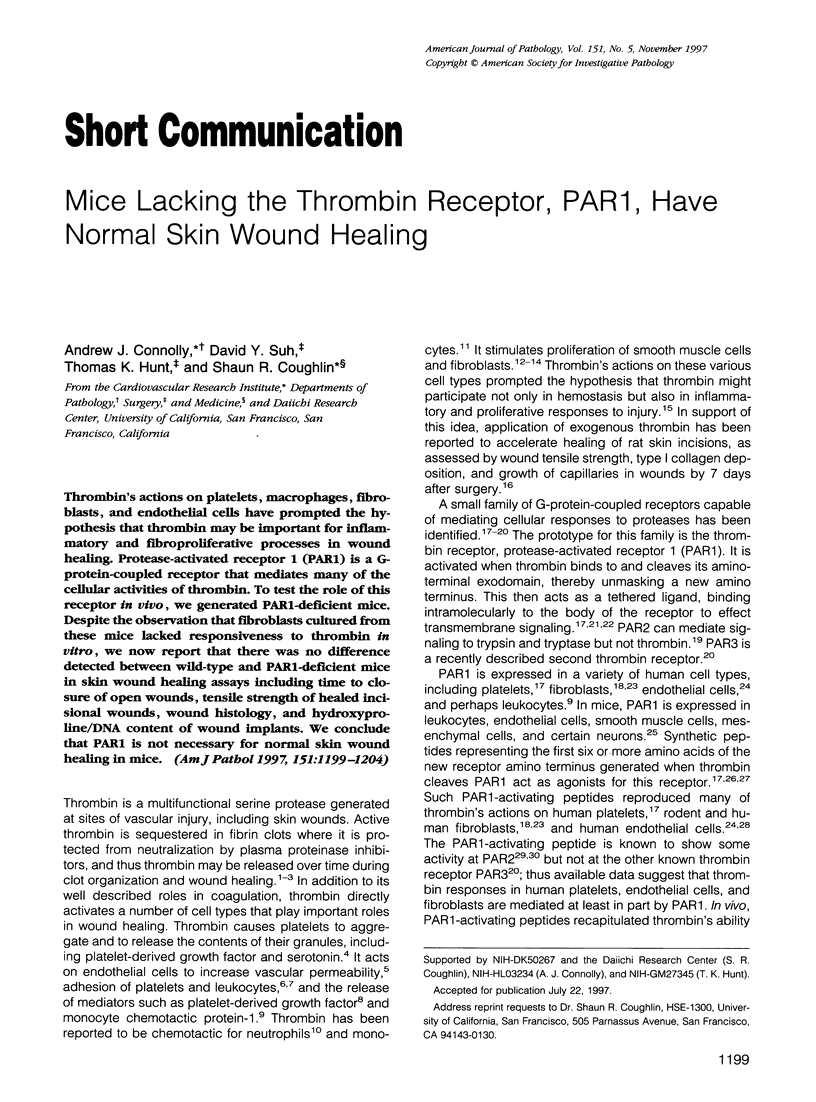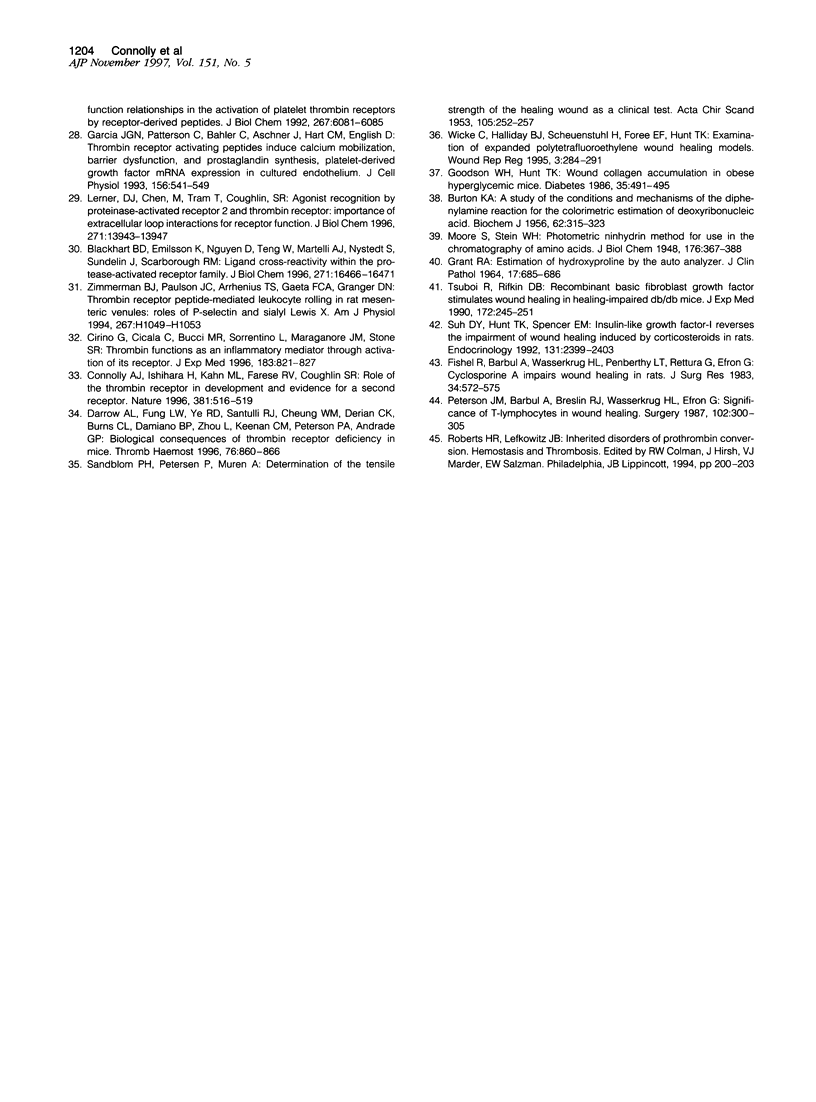Abstract
Thrombin's actions on platelets, macrophages, fibroblasts, and endothelial cells have prompted the hypothesis that thrombin may be important for inflammatory and fibroproliferative processes in wound healing. Protease-activated receptor 1 (PAR1) is a G-protein-coupled receptor that mediates many of the cellular activities of thrombin. To test the role of this receptor in vivo, we generated PAR1-deficient mice. Despite the observation that fibroblasts cultured from these mice lacked responsiveness to thrombin in vitro, we now report that there was no difference detected between wild-type and PAR1-deficient mice in skin wound healing assays including time to closure of open wounds, tensile strength of healed incisional wounds, wound histology, and hydroxyproline/DNA content of wound implants. We conclude that PAR1 is not necessary for normal skin wound healing in mice.
Full text
PDF





Images in this article
Selected References
These references are in PubMed. This may not be the complete list of references from this article.
- BURTON K. A study of the conditions and mechanism of the diphenylamine reaction for the colorimetric estimation of deoxyribonucleic acid. Biochem J. 1956 Feb;62(2):315–323. doi: 10.1042/bj0620315. [DOI] [PMC free article] [PubMed] [Google Scholar]
- Bar-Shavit R., Kahn A., Wilner G. D., Fenton J. W., 2nd Monocyte chemotaxis: stimulation by specific exosite region in thrombin. Science. 1983 May 13;220(4598):728–731. doi: 10.1126/science.6836310. [DOI] [PubMed] [Google Scholar]
- Blackhart B. D., Emilsson K., Nguyen D., Teng W., Martelli A. J., Nystedt S., Sundelin J., Scarborough R. M. Ligand cross-reactivity within the protease-activated receptor family. J Biol Chem. 1996 Jul 12;271(28):16466–16471. doi: 10.1074/jbc.271.28.16466. [DOI] [PubMed] [Google Scholar]
- Carney D. H., Mann R., Redin W. R., Pernia S. D., Berry D., Heggers J. P., Hayward P. G., Robson M. C., Christie J., Annable C. Enhancement of incisional wound healing and neovascularization in normal rats by thrombin and synthetic thrombin receptor-activating peptides. J Clin Invest. 1992 May;89(5):1469–1477. doi: 10.1172/JCI115737. [DOI] [PMC free article] [PubMed] [Google Scholar]
- Chen J., Ishii M., Wang L., Ishii K., Coughlin S. R. Thrombin receptor activation. Confirmation of the intramolecular tethered liganding hypothesis and discovery of an alternative intermolecular liganding mode. J Biol Chem. 1994 Jun 10;269(23):16041–16045. [PubMed] [Google Scholar]
- Chen L. B., Buchanan J. M. Mitogenic activity of blood components. I. Thrombin and prothrombin. Proc Natl Acad Sci U S A. 1975 Jan;72(1):131–135. doi: 10.1073/pnas.72.1.131. [DOI] [PMC free article] [PubMed] [Google Scholar]
- Cirino G., Cicala C., Bucci M. R., Sorrentino L., Maraganore J. M., Stone S. R. Thrombin functions as an inflammatory mediator through activation of its receptor. J Exp Med. 1996 Mar 1;183(3):821–827. doi: 10.1084/jem.183.3.821. [DOI] [PMC free article] [PubMed] [Google Scholar]
- Colotta F., Sciacca F. L., Sironi M., Luini W., Rabiet M. J., Mantovani A. Expression of monocyte chemotactic protein-1 by monocytes and endothelial cells exposed to thrombin. Am J Pathol. 1994 May;144(5):975–985. [PMC free article] [PubMed] [Google Scholar]
- Connolly A. J., Ishihara H., Kahn M. L., Farese R. V., Jr, Coughlin S. R. Role of the thrombin receptor in development and evidence for a second receptor. Nature. 1996 Jun 6;381(6582):516–519. doi: 10.1038/381516a0. [DOI] [PubMed] [Google Scholar]
- Darrow A. L., Fung-Leung W. P., Ye R. D., Santulli R. J., Cheung W. M., Derian C. K., Burns C. L., Damiano B. P., Zhou L., Keenan C. M. Biological consequences of thrombin receptor deficiency in mice. Thromb Haemost. 1996 Dec;76(6):860–866. [PubMed] [Google Scholar]
- Ehringer W. D., Edwards M. J., Miller F. N. Mechanisms of alpha-thrombin, histamine, and bradykinin induced endothelial permeability. J Cell Physiol. 1996 Jun;167(3):562–569. doi: 10.1002/(SICI)1097-4652(199606)167:3<562::AID-JCP20>3.0.CO;2-4. [DOI] [PubMed] [Google Scholar]
- Fenton J. W., 2nd, Ofosu F. A., Brezniak D. V., Hassouna H. I. Understanding thrombin and hemostasis. Hematol Oncol Clin North Am. 1993 Dec;7(6):1107–1119. [PubMed] [Google Scholar]
- Fishel R., Barbul A., Wasserkrug H. L., Penberthy L. T., Rettura G., Efron G. Cyclosporine A impairs wound healing in rats. J Surg Res. 1983 Jun;34(6):572–575. doi: 10.1016/0022-4804(83)90112-9. [DOI] [PubMed] [Google Scholar]
- Francis C. W., Markham R. E., Jr, Barlow G. H., Florack T. M., Dobrzynski D. M., Marder V. J. Thrombin activity of fibrin thrombi and soluble plasmic derivatives. J Lab Clin Med. 1983 Aug;102(2):220–230. [PubMed] [Google Scholar]
- GRANT R. A. ESTIMATION OF HYDROXYPROLINE BY THE AUTOANALYSER. J Clin Pathol. 1964 Nov;17:685–686. doi: 10.1136/jcp.17.6.685. [DOI] [PMC free article] [PubMed] [Google Scholar]
- Garcia J. G., Patterson C., Bahler C., Aschner J., Hart C. M., English D. Thrombin receptor activating peptides induce Ca2+ mobilization, barrier dysfunction, prostaglandin synthesis, and platelet-derived growth factor mRNA expression in cultured endothelium. J Cell Physiol. 1993 Sep;156(3):541–549. doi: 10.1002/jcp.1041560313. [DOI] [PubMed] [Google Scholar]
- Goodson W. H., 3rd, Hunt T. K. Wound collagen accumulation in obese hyperglycemic mice. Diabetes. 1986 Apr;35(4):491–495. doi: 10.2337/diab.35.4.491. [DOI] [PubMed] [Google Scholar]
- Hattori R., Hamilton K. K., Fugate R. D., McEver R. P., Sims P. J. Stimulated secretion of endothelial von Willebrand factor is accompanied by rapid redistribution to the cell surface of the intracellular granule membrane protein GMP-140. J Biol Chem. 1989 May 15;264(14):7768–7771. [PubMed] [Google Scholar]
- Hung D. T., Vu T. H., Nelken N. A., Coughlin S. R. Thrombin-induced events in non-platelet cells are mediated by the unique proteolytic mechanism established for the cloned platelet thrombin receptor. J Cell Biol. 1992 Feb;116(3):827–832. doi: 10.1083/jcb.116.3.827. [DOI] [PMC free article] [PubMed] [Google Scholar]
- Ishihara H., Connolly A. J., Zeng D., Kahn M. L., Zheng Y. W., Timmons C., Tram T., Coughlin S. R. Protease-activated receptor 3 is a second thrombin receptor in humans. Nature. 1997 Apr 3;386(6624):502–506. doi: 10.1038/386502a0. [DOI] [PubMed] [Google Scholar]
- Jenkins A. L., Howells G. L., Scott E., Le Bonniec B. F., Curtis M. A., Stone S. R. The response to thrombin of human neutrophils: evidence for two novel receptors. J Cell Sci. 1995 Sep;108(Pt 9):3059–3066. doi: 10.1242/jcs.108.9.3059. [DOI] [PubMed] [Google Scholar]
- Lerner D. J., Chen M., Tram T., Coughlin S. R. Agonist recognition by proteinase-activated receptor 2 and thrombin receptor. Importance of extracellular loop interactions for receptor function. J Biol Chem. 1996 Jun 14;271(24):13943–13947. [PubMed] [Google Scholar]
- Liu C. Y., Nossel H. L., Kaplan K. L. The binding of thrombin by fibrin. J Biol Chem. 1979 Oct 25;254(20):10421–10425. [PubMed] [Google Scholar]
- McNamara C. A., Sarembock I. J., Gimple L. W., Fenton J. W., 2nd, Coughlin S. R., Owens G. K. Thrombin stimulates proliferation of cultured rat aortic smooth muscle cells by a proteolytically activated receptor. J Clin Invest. 1993 Jan;91(1):94–98. doi: 10.1172/JCI116206. [DOI] [PMC free article] [PubMed] [Google Scholar]
- Ngaiza J. R., Jaffe E. A. A 14 amino acid peptide derived from the amino terminus of the cleaved thrombin receptor elevates intracellular calcium and stimulates prostacyclin production in human endothelial cells. Biochem Biophys Res Commun. 1991 Sep 30;179(3):1656–1661. doi: 10.1016/0006-291x(91)91765-5. [DOI] [PubMed] [Google Scholar]
- Nystedt S., Emilsson K., Wahlestedt C., Sundelin J. Molecular cloning of a potential proteinase activated receptor. Proc Natl Acad Sci U S A. 1994 Sep 27;91(20):9208–9212. doi: 10.1073/pnas.91.20.9208. [DOI] [PMC free article] [PubMed] [Google Scholar]
- Peterson J. M., Barbul A., Breslin R. J., Wasserkrug H. L., Efron G. Significance of T-lymphocytes in wound healing. Surgery. 1987 Aug;102(2):300–305. [PubMed] [Google Scholar]
- Rasmussen U. B., Vouret-Craviari V., Jallat S., Schlesinger Y., Pagès G., Pavirani A., Lecocq J. P., Pouysségur J., Van Obberghen-Schilling E. cDNA cloning and expression of a hamster alpha-thrombin receptor coupled to Ca2+ mobilization. FEBS Lett. 1991 Aug 19;288(1-2):123–128. doi: 10.1016/0014-5793(91)81017-3. [DOI] [PubMed] [Google Scholar]
- SANDBLOM P., PETERSEN P., MUREN A. Determination of the tensile strength of the healing wound as a clinical test. Acta Chir Scand. 1953;105(1-4):252–257. [PubMed] [Google Scholar]
- Scarborough R. M., Naughton M. A., Teng W., Hung D. T., Rose J., Vu T. K., Wheaton V. I., Turck C. W., Coughlin S. R. Tethered ligand agonist peptides. Structural requirements for thrombin receptor activation reveal mechanism of proteolytic unmasking of agonist function. J Biol Chem. 1992 Jul 5;267(19):13146–13149. [PubMed] [Google Scholar]
- Shankar R., de la Motte C. A., Poptic E. J., DiCorleto P. E. Thrombin receptor-activating peptides differentially stimulate platelet-derived growth factor production, monocytic cell adhesion, and E-selectin expression in human umbilical vein endothelial cells. J Biol Chem. 1994 May 13;269(19):13936–13941. [PubMed] [Google Scholar]
- Shuman M. A., Botney M., Fenton J. W., 2nd Thrombin-induced platelet secretion. Further evidence for a specific pathway. J Clin Invest. 1979 Jun;63(6):1211–1218. doi: 10.1172/JCI109416. [DOI] [PMC free article] [PubMed] [Google Scholar]
- Soifer S. J., Peters K. G., O'Keefe J., Coughlin S. R. Disparate temporal expression of the prothrombin and thrombin receptor genes during mouse development. Am J Pathol. 1994 Jan;144(1):60–69. [PMC free article] [PubMed] [Google Scholar]
- Suh D. Y., Hunt T. K., Spencer E. M. Insulin-like growth factor-I reverses the impairment of wound healing induced by corticosteroids in rats. Endocrinology. 1992 Nov;131(5):2399–2403. doi: 10.1210/endo.131.5.1425438. [DOI] [PubMed] [Google Scholar]
- Trejo J., Connolly A. J., Coughlin S. R. The cloned thrombin receptor is necessary and sufficient for activation of mitogen-activated protein kinase and mitogenesis in mouse lung fibroblasts. Loss of responses in fibroblasts from receptor knockout mice. J Biol Chem. 1996 Aug 30;271(35):21536–21541. doi: 10.1074/jbc.271.35.21536. [DOI] [PubMed] [Google Scholar]
- Tsuboi R., Rifkin D. B. Recombinant basic fibroblast growth factor stimulates wound healing in healing-impaired db/db mice. J Exp Med. 1990 Jul 1;172(1):245–251. doi: 10.1084/jem.172.1.245. [DOI] [PMC free article] [PubMed] [Google Scholar]
- Vu T. K., Hung D. T., Wheaton V. I., Coughlin S. R. Molecular cloning of a functional thrombin receptor reveals a novel proteolytic mechanism of receptor activation. Cell. 1991 Mar 22;64(6):1057–1068. doi: 10.1016/0092-8674(91)90261-v. [DOI] [PubMed] [Google Scholar]
- Vu T. K., Wheaton V. I., Hung D. T., Charo I., Coughlin S. R. Domains specifying thrombin-receptor interaction. Nature. 1991 Oct 17;353(6345):674–677. doi: 10.1038/353674a0. [DOI] [PubMed] [Google Scholar]
- Wicke C., Halliday B. J., Scheuenstuhl H., Foree E. F., Hunt T. K. Examination of expanded polytetrafluoroethylene wound healing models. Wound Repair Regen. 1995 Jul–Sep;3(3):284–291. doi: 10.1046/j.1524-475X.1995.30308.x. [DOI] [PubMed] [Google Scholar]
- Wilner G. D., Danitz M. P., Mudd M. S., Hsieh K. H., Fenton J. W., 2nd Selective immobilization of alpha-thrombin by surface-bound fibrin. J Lab Clin Med. 1981 Mar;97(3):403–411. [PubMed] [Google Scholar]
- Zimmerman B. J., Paulson J. C., Arrhenius T. S., Gaeta F. C., Granger D. N. Thrombin receptor peptide-mediated leukocyte rolling in rat mesenteric venules: roles of P-selectin and sialyl Lewis X. Am J Physiol. 1994 Sep;267(3 Pt 2):H1049–H1053. doi: 10.1152/ajpheart.1994.267.3.H1049. [DOI] [PubMed] [Google Scholar]
- Zimmerman G. A., McIntyre T. M., Prescott S. M. Thrombin stimulates neutrophil adherence by an endothelial cell-dependent mechanism: characterization of the response and relationship to platelet-activating factor synthesis. Ann N Y Acad Sci. 1986;485:349–368. doi: 10.1111/j.1749-6632.1986.tb34596.x. [DOI] [PubMed] [Google Scholar]



